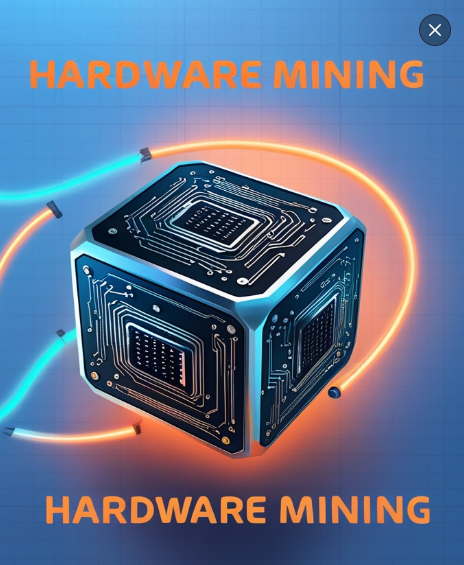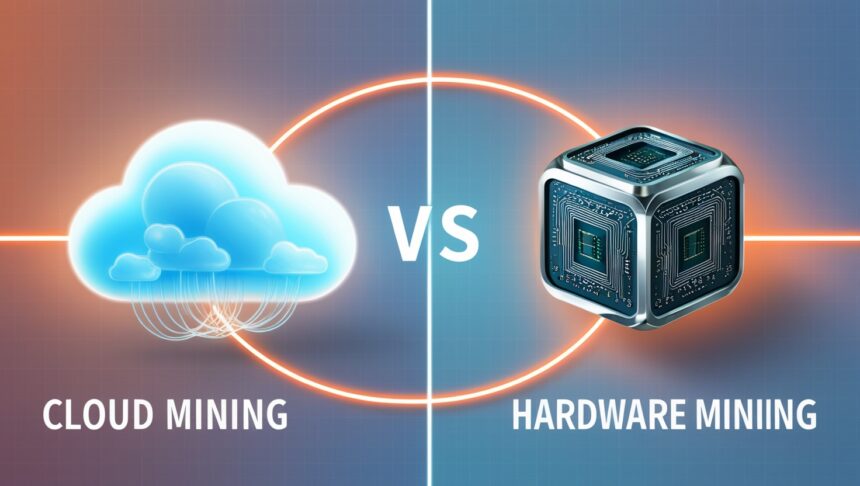In this article, I will analyze the Cloud Mining vs Hardware Mining. Both methods are popular but have unique pros and cons when it comes to mining cryptocurrency.
Learning the specifics of cloud and hardware mining will allow one to decide which method best aligns with their plans, whether they require a more automated or involved system setup.
What is Cloud Mining?
Cloud mining enables users to mine cryptocurrencies without owning any physical mining hardware.
Unlike traditional mining, users need not purchase costly equipment as they can rent mining power from a cloud service provider.

Such providers maintain large-scale operations in remote data centers and users can buy contracts to mine at these centers.
This method provides an effortless way for people who want to mine cryptocurrencies but do not have the knowledge or resources to set up the hardware.
What is Hardware Mining?
Mining through hardware entails the use of physical mining equipment like GPUs and ASICs. Each miner buys, configures, and services his or her own device which solves intricate cryptographic puzzles to earn rewards.

Unlike cloud mining, hardware mining has a higher initial cost because of the equipment needed and additional recurring expenditures on energy, maintenance, and cooling.
While offering more autonomy in the mining process, it can be resource demanding and requires a certain degree of technical expertise to be run effectively.
Cloud Mining vs Hardware Mining
| Aspect | Cloud Mining | Hardware Mining |
|---|---|---|
| Ownership | No physical ownership of mining equipment | Full ownership of mining hardware |
| Initial Investment | Low, only requires renting mining power | High, requires purchasing mining hardware |
| Maintenance | Handled by service provider | Managed by the miner, includes maintenance and repairs |
| Energy Costs | Lower, as energy costs are covered by the provider | Higher, due to electricity consumption of the hardware |
| Control | Limited, depends on the provider’s settings | Full control over hardware, software, and coins mined |
| Scalability | Flexible, can scale up or down easily | Limited by the hardware and infrastructure available |
| Profit Potential | Lower, due to fees paid to the provider | Higher, as there are no intermediary fees |
| Location | Remote, can be accessed from anywhere | Location-dependent, hardware setup required |
| Risk of Obsolescence | Lower, hardware is upgraded by the provider | High, hardware can become outdated quickly |
| Noise & Heat | No noise or heat generation | High noise and heat production |
| Technical Expertise | Low, provider handles the technical side | High, requires knowledge of hardware setup and management |
How Cloud Mining Works
Your preferred coin, required hash rate, and contract duration will help you choose a contract. After starting the contract, you receive payments based on the earnings of the provider.
Usually, most of the platforms impose maintenance and electricity costs, which are frequently withheld from your revenue earnings automatically.

ECOS Crypto, Genesis Mining, and Hashing24 are among the most popular cloud mining services. These platforms offer packages for Bitcoin and other proof of work coins.
Types of Cloud Mining
Hosted Mining: You lease a mining machine, which the provider hosts for you.
Virtual Hosted Mining: You lease a virtual server and upload personal mining software which you are free to install.
Leased Hashing Power: You lease part of the hashing power of the company with no dedicated machine or server.
How Hardware Mining Works?
Cryptocurrency mining can be done using specialized equipment known as hardware mining. These machines are physically set up on a blockchain network. They include ASICs (Application-Specific Integrated Circuits) or GPUs (Graphics Processing Units).
They ‘compete’ to ‘solve’ intricate algorithms needed to validate transactions, and the first to solve gets the reward of cryptocurrency. Once devices are attached to the network, they function autonomously.

In order to maintain peak performance, a stable source of power, constant maintenance, and efficient cooling systems are required.
Compared to other mining methods, hardware mining allows for a greater level of autonomy since users have complete control over software, equipment, and even coins to be mined.
Different Types of Mining Hardware
ASIC Miners: These miners utilize specific machines designed only for the purpose of mining.
GPU Miners: Mining can also be done through video cards used widely by gamers.
CPU Miners: This involves mining through your PC’s central processing unit which is more inefficient.
Advantages of Cloud Mining
Cloud mining provides many advantages that lure people to this method of cryptocurrency mining. It equalizes the competition as it gives access to the mining world for people who do not possess the resources for a traditional setup.
No Equipment Needed: Owing to cloud mining, purchasing costly hardware is not a prerequisite, thereby conserving capital and eliminating the possibility of the equipment becoming outdated.
Reduced Power Expenses: As users are not responsible for the electricity bills incurred while running mining hardware, the expenditure on energy resources is lowered.
Lower Maintenance Burden: Technical aspects like work management and machinery maintenance are the sole responsibility of the service provider.
Adaptability and Scalability: Cloud miners are in a position to command their investments and scale to new heights due to personal targets or prevailing circumstances.
Access to all Users Globally: Geographical restrictions do not apply to cloud mining. It allows any person from any area to engage in cryptocurrency mining.
The benefits are particularly useful for people who have limited funds and face looming technical complexity as cloud mining is ideal for such situations.
Challenges of Cloud Mining
Lacking proper resources can be detrimental to profitability and presents an unattractive experience due to lacking cloud mining benefits.
Lower Earnings: Renting out mining services will, in most cases, be less rewarding relative to owning and managing hardware due to diminished rewards.
Risk of Scams: There are many scammers in cloud mining, so it is imperative to be cautious when choosing the most suitable provider.
Limited Control: Miners are dependent on third-party service providers which results in lesser control over the process including the coins mined and the resources consumed.
Contract Restrictions: Their long-term market strategies could be affected by changes in fixed-term contracts due to personal conditions.
Market Volatility: Arbitrary price shifts in cryptocurrency might pose considerable disadvantages to the profitability margin of cloud mining.
Benefits of Hardware Mining
Compared to cloud mining, hardware mining takes up more resources, however, it gives many crypto enthusiasts good reasons to get into the activity.
Full Ownership & Control: Such a miner can exercise full power over their operations and decide on the hardware, software, and even types of cryptocurrency to mine.
Higher Profit Potential: Since miners have full control of the entire process, hardware miners stand to benefit from higher earnings due to no third party provider fee split.
Direct Payouts: Miners receive the earned rewards straight from their work without any parties involved in between – thus receiving the entire payment meant for them.
Customizable Setup: Advanced users can adjust their specific software and hardware parameters to achieve efficient mining, increasing the optimization level.
Tangible Assets: The mining equipment can be regarded as tangible property because they can be sold, repurposed premises or assets of the mining operation.
Individuals who have a willingness to spend time and capital into the endeavor of mining cryptocurrency will find that it quite easily becomes a rewarding venture both financially and on a personal level.
Drawbacks of Hardware Mining
On the downside, these are some of challenges that people have to think about not before but actually after pursuing such a venture, but rather during the course of hardware mining.
High Upfront Investment: For individuals or businesses with lower capital, purchasing state-of-the-art mining equipment comes with a high upfront cost.
Operational Complexity: Cooling systems and power infrastructure require stable and operational environments that are often complex to set up and maintain.
Ongoing Maintenance: The time, effort, and money it requires to maintain and repair hardware can be extensive for miners.
Noise & Heat: A cooling system is often a requirement for mining rigs in order to improve uncomfortable working conditions.
Risk of Obsolescence: Continuous upgrades are necessary due to the rapid changes in technology and the fast pace at which mining hardware becomes outdated.
Fixed Location: Relocating a hardware mining setup poses a logistical challenge and is oftentimes deemed dangerous.
Making the Right Choice in Mining
Selecting a type of mining investment strategy requires determining whether you prefer cloud mining or hardware mining because each has its advantages and disadvantages.
Cloud mining is a great option for low-maintenance beginners since it requires limited initial investment and ongoing management.
On the contrary, hardware mining tends to benefit proficient miners willing to tackle equipment and operational complexities because of the autonomy and greater profits it offers.
Focusing on specifics such as the level of investment, risk appetite, and hands-on involvement needed will assist in picking the appropriate type of mining strategy that best suits your requirements.
Is Cloud Mining & Hardware Mining Safe?
Both choices involve considerations of risks and security when it comes to cloud and hardware mining:
Cloud Mining: This type of mining can be safe, but only if you select a trustworthy provider. The industry has its fair share of scams and unreliable contracts. Thorough research is critical before any investment.
Hardware Mining: Provides better control and clarity, but comes with the risk of equipment failure, overheating, and higher energy costs. Safety, in this causes, relies upon proper setup and maintenance.
In both scenarios, due diligence alongside risk understanding directly dictates your safety.
Conclusion
Similar to other aspects of life, both cloud and hardware mining possess distinct advantages and disadvantages.
Cloud mining is simple and requires less maintenance with a more beginner-friendly approach, whereas, hardware mining offers unparalleled flexibility, control, and increased profits in the long run for more technically inclined users.
Each option can be best suited depending on the investment amount, risks one is willing to take, as well as the level of engagement desired.










